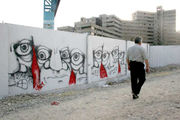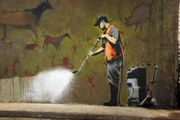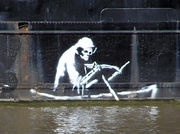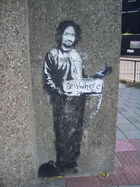Graffiti
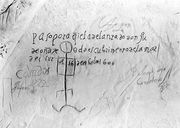
Graffiti (singular: graffito; the plural is used as a mass noun) is the name for images or lettering scratched, scrawled, painted or marked in any manner on property. Graffiti is any type of public markings that may appear in the forms of simple written words to elaborate wall paintings. Graffiti has existed since ancient times, with examples dating back to Ancient Greece and the Roman Empire.[1] In modern times, spray paint, normal paint and markers have become the most commonly used materials. In most countries, defacing property with graffiti without the property owner's consent is considered vandalism, which is punishable by law. Sometimes graffiti is employed to communicate social and political messages. To some, it is an art form worthy of display in galleries and exhibitions; to others it is merely vandalism. Graffiti has since evolved into a pop culture existence often related to underground hip hop music and b-boying creating a lifestyle that remains hidden from the general public.[2] Graffiti can be used as a gang signal to mark territory or to serve as an indicator or "tag" for gang-related activity. The controversies that surround graffiti continue to create disagreement amongst city officials/law enforcement and graffitists looking to display their work in public locations. There are many different types and styles of graffiti and it is a rapidly developing artform whose value is highly contested, being reviled by many authorities while also subject to protection, sometimes within the same jurisdiction.
| Street art |
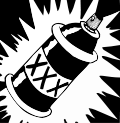 |
| Street art formats |
|
Graffiti • Stencils • Sticker art |
| Street artists |
|
List of street artists |
| Graffiti culture |
|
Activism |
| Artist ideologies |
|
Art intervention |
| Street art-related |
|
Built environment |
| Street art by country |
|
Australia • Spain • Germany |
Contents |
Etymology
Graffiti and graffito are from the Italian word graffiato ("scratched"). "Graffiti" is applied in art history to works of art produced by scratching a design into a surface. A related term is "graffito", which involves scratching through one layer of pigment to reveal another beneath it. This technique was primarily used by potters who would glaze their wares and then scratch a design into it. In ancient times graffiti was carved on walls with a sharp object, although sometimes chalk or coal were used. The Greek infinitive γράφειν — graphein — meaning "to write", is from the same root.
History
The term graffiti referred to the inscriptions, figure drawings, etc., found on the walls of ancient sepulchers or ruins, as in the Catacombs of Rome or at Pompeii. Usage of the word has evolved to include any graphics applied to surfaces in a manner that constitutes vandalism.
The earliest forms of graffiti date back to 30,000 BCE in the form of prehistoric cave paintings and pictographs using tools such as animal bones and pigments.[3] These illustrations were often placed in ceremonial and sacred locations inside of the caves. The images drawn on the walls showed scenes of animal wildlife and hunting expeditions in most circumstances. This form of graffiti is subject to disagreement considering it is likely that members of prehistoric society endorsed the creation of these illustrations.
The only known source of the Safaitic language, a form of proto-Arabic, is from graffiti: inscriptions scratched on to the surface of rocks and boulders in the predominantly basalt desert of southern Syria, eastern Jordan and northern Saudi Arabia. Safaitic dates from the 1st century BCE to the 4th century CE.
Modern-style graffiti
The first known example of "modern style" graffiti survives in the ancient Greek city of Ephesus (in modern-day Turkey). Local guides say it is an advertisement for prostitution. Located near a mosaic and stone walkway, the graffiti shows a handprint that vaguely resembles a heart, along with a footprint and a number. This is believed to indicate that a brothel was nearby, with the handprint symbolizing payment.[4]
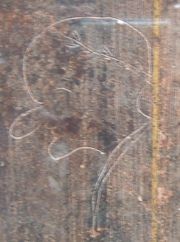
The ancient Romans carved graffiti on walls and monuments, examples of which also survive in Egypt. Graffiti in the classical world had different connotations than it carries in today's society concerning content. Ancient graffiti displayed phrases of love declarations, political rhetoric, and simple words of thought compared to today's popular messages of social and political ideals[5] The eruption of Vesuvius preserved graffiti in Pompeii, including Latin curses, magic spells, declarations of love, alphabets, political slogans and famous literary quotes, providing insight into ancient Roman street life. One inscription gives the address of a woman named Novellia Primigenia of Nuceria, a prostitute, apparently of great beauty, whose services were much in demand. Another shows a phallus accompanied by the text, 'mansueta tene': "Handle with care".
Disappointed love also found its way onto walls in antiquity:
- Quisquis amat. veniat. Veneri volo frangere costas
- fustibus et lumbos debilitare deae.
- Si potest illa mihi tenerum pertundere pectus
- quit ego non possim caput illae frangere fuste?
- Whoever loves, go to hell. I want to break Venus's ribs
- with a club and deform her hips.
- If she can break my tender heart
- why can't I hit her over the head?
- -CIL IV, 1284.

Historic forms of graffiti have helped gain understanding into the lifestyles and languages of past cultures. Errors in spelling and grammar in this graffiti offer insight into the degree of literacy in Roman times and provide clues on the pronunciation of spoken Latin. Examples are CIL IV, 7838: Vettium Firmum / aed[ilem] quactiliar[ii] [sic] rog[ant]. Here, "qu" is pronounced "co." The 83 pieces of graffiti found at CIL IV, 4706-85 are evidence of the ability to read and write at levels of society where literacy might not be expected. The graffiti appear on a peristyle which was being remodeled at the time of the eruption of Vesuvius by the architect Crescens. The graffiti was left by both the foreman and his workers. The brothel at CIL VII, 12, 18-20 contains over 120 pieces of graffiti, some of which were the work of the prostitutes and their clients. The gladiatorial academy at CIL IV, 4397 was scrawled with graffiti left by the gladiator Celadus Crescens (Suspirium puellarum Celadus thraex: "Celadus the Thracian makes the girls sigh.")
Another piece from Pompeii, written on a tavern wall about the owner of the establishment and his questionable wine:
- Landlord, may your lies malign
- Bring destruction on your head!
- You yourself drink unmixed wine,
- Water sell your guests instead.[6]
It was not only the Greeks and Romans that produced graffiti: the Mayan site of Tikal in Guatemala also contains ancient examples. Viking graffiti survive in Rome and at Newgrange Mound in Ireland, and a Varangian scratched his name (Halvdan) in runes on a banister in the Hagia Sophia at Constantinople.These early forms of graffiti have contributed to the understanding of lifestyles and languages of past cultures.
Graffiti, known as Tacherons, were frequently scratched on Romanesque Scandinavian church walls.[7]
When Renaissance artists such as Pinturicchio, Raphael, Michelangelo, Ghirlandaio or Filippino Lippi descended into the ruins of Nero's Domus Aurea, they carved or painted their names[8][9] and returned with the grottesche style of decoration. There are also examples of graffiti occurring in American history, such as Signature Rock, a national landmark along the Oregon Trail.
Later, French soldiers carved their names on monuments during the Napoleonic campaign of Egypt in the 1790s.[10] Lord Byron's survives on one of the columns of the Temple of Poseidon at Cape Sounion in Attica, Greece.[11]
Modern graffiti
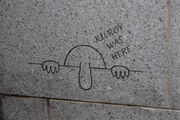
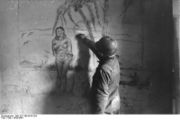
Graffiti is often seen as having become intertwined with hip hop culture and the myriad of international styles derived from New York City Subway graffiti (see below). However, there are many other instances of notable graffiti this century. Graffiti has long appeared on railroad boxcars and subways. The one with the longest history, dating back to the 1920s and continuing into the present day, is Texino.[12] During World War II and for decades after, the phrase "Kilroy was here" with accompanying illustration was widespread throughout the world, due to its use by American troops and its filtering into American popular culture. Shortly after the death of Charlie Parker (nicknamed "Yardbird" or "Bird"), graffiti began appearing around New York with the words "Bird Lives".[13] The student protests and general strike of May 1968 saw Paris bedecked in revolutionary, anarchist, and situationist slogans such as L'ennui est contre-révolutionnaire ("Boredom is counterrevolutionary") expressed in painted graffiti, poster art, and stencil art. In the U.S. at the time other political phrases (such as "Free Huey" about Black Panther Huey Newton) became briefly popular as graffiti in limited areas, only to be forgotten. A popular graffito of the 1970s was the legend "Dick Nixon Before He Dicks You", reflecting the hostility of the youth culture to that U.S. president.
Rock and roll graffiti is a significant sub genre. A famous graffito of the 20th century was the inscription in the London subway reading "Clapton is God". The phrase was spray-painted by an admirer on a wall in an Islington Underground station in the autumn of 1967. The graffiti was captured in a photograph, in which a dog is urinating on the wall. Graffiti also became associated with the anti-establishment punk rock movement beginning in the 1970s. Bands such as Black Flag and Crass (and their followers) widely stenciled their names and logos, while many punk night clubs, squats and hangouts are famous for their graffiti. In the late 1980s the upside down Martini glass that was the tag for punk band Missing Foundation was the most ubiquitous graffito in lower Manhattan, and copied by hard core punk fans throughout the U.S. and West Germany.[14]
Along similar lines was the legend "Frodo Lives", referring to the protagonist of The Lord of the Rings.
Spread of graffiti culture
In 1979, graffiti artist Lee Quinones and Fab 5 Freddy were given a gallery opening in Rome by art dealer Claudio Bruni. For many outside of New York, it was their first encounter with the art form. Fab 5 Freddy's friendship with Debbie Harry influenced Blondie's single "Rapture" (Chrysalis, 1981), the video of which featured Jean-Michel Basquiat of the SAMO© Graffiti, and offered many their first glimpse of a depiction of elements of graffiti in hip hop culture. More important here was Charlie Ahearn's independently released fiction film Wild Style (Wild Style, 1982), and the early PBS documentary Style Wars (1983). Hit songs such as "The Message" and "Planet Rock" and their accompanying music videos (both 1982) contributed to a growing interest outside New York in all aspects of hip hop.Style Wars depicted not only famous graffiti artists such as Skeme, Dondi, MinOne and Zephyr, but also reinforced graffiti's role within New York's emerging hip hop culture by incorporating famous early break dancing groups such as Rock Steady Crew into the film which also features a solely rap soundtrack. Style Wars is still recognized as the most prolific film representation of what was going on within the young hip hop culture of the early 1980s.[15] Fab 5 Freddy and Futura 2000 took hip hop graffiti to Paris and London as part of the New York City Rap Tour in 1983.[16] Hollywood also paid attention, consulting writers like PHASE 2 as it depicted the culture and gave it international exposure in movies like Beat Street (Orion, 1984).
This period also saw the emergence of the new stencil graffiti genre. Some of the first examples were created ca 1981 by graffiti artist Blek le Rat in Paris; by 1985 stencils had appeared in other cities including New York City, Sydney and Melbourne, where they were documented by American photographer Charles Gatewood and Australian photographer Rennie Ellis.[17]
Graffiti as a memorial
People often leave their traces in wet cement or concrete. This type of graffiti often commemorates the mutual commitment of a couple, or simply records a person's presence at a particular moment. Often this type of graffiti is dated and is left untouched for decades, offering a look into local historical minutiae.
Commercialization and entrance into mainstream pop culture
With the popularity and legitimization of graffiti has come a level of commercialization or graffiti for hire. In 2001, computer giant IBM launched an advertising campaign in Chicago and San Francisco which involved people spray painting on sidewalks a peace symbol, a heart, and a penguin (Linux mascot), to represent "Peace, Love, and Linux." However due to illegalities some of the "street artists" were arrested and charged with vandalism, and IBM was fined more than US$120,000 for punitive and clean-up costs.[18][19]
In 2005, a similar ad campaign was launched by Sony and executed by TATS CRU in New York, Chicago, Atlanta, Philadelphia, Los Angeles and Miami in order to market its handheld PSP gaming system. In this campaign, taking notice of the legal problems of the IBM campaign, Sony paid building owners for the rights to paint on their buildings "a collection of dizzy-eyed urban kids playing with the PSP as if it were a skateboard, a paddle or a rocking horse."[19]
Along with the commercial growth has come the rise of video games also depicting graffiti, usually in a positive aspect – for example, the Jet Set Radio series (2000–2003) tells the story of a group of teens fighting the oppression of a totalitarian police force that attempts to limit the graffiti artists' freedom of speech. In plotlines mirroring the negative reaction of non-commercial artists to the commercialization of the artform by companies like IBM (and, later, Sony itself) the Rakugaki Ōkoku series (2003–2005) for Sony's PlayStation 2 revolves around an anonymous hero and his magically imbued-with-life graffiti creations as they struggle against an evil king who only allows art to be produced which can benefit him. Following the original roots of modern graffiti as a political force came another game title, Marc Eckō's Getting Up: Contents Under Pressure (2006), featuring a story line involving fighting against a corrupt city and its oppression of free speech, as in the Jet Set Radio series.
Other games which feature graffiti include Bomb the World (2004), an online graffiti simulation created by graffiti artist Klark Kent where users can virtually paint trains at 20 locations worldwide, and Super Mario Sunshine (2002), in which the hero, Mario must clean the city of graffiti left by the villain, Bowser Jr. in a plotline which evokes the successes of the Anti-Graffiti Task Force of New York's Mayor Rudolph Giuliani (a manifestation of "broken window theory") or those of the "Graffiti Blasters" of Chicago's Mayor Richard M. Daley.
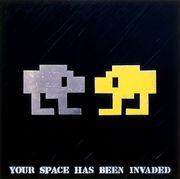
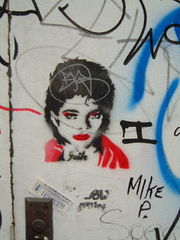
Numerous other non-graffiti-centric video games allow the player to produce graffiti (such as the Half-Life series, the Tony Hawk's series, The Urbz: Sims in the City, Rolling and Grand Theft Auto: San Andreas). Counter-Strike which is a Half-Life mod allows user to create their own and tag in game. Many other titles contain in-game depictions of graffiti (such as The Darkness, Double Dragon 3: The Rosetta Stone, NetHack, Samurai Champloo: Sidetracked, The World Ends With You, The Warriors, Just Cause, Portal, various examples of Virtual Graffiti, etc.). There also exist a host of games where the term "graffiti" is used as a synonym for "drawing" (such as Yahoo! Graffiti, Graffiti, etc.).
Marc Ecko, an urban clothing designer, has been an advocate of graffiti as an art form during this period, stating that "Graffiti is without question the most powerful art movement in recent history and has been a driving inspiration throughout my career."[20]
Keith Haring was another well-known graffiti artist who brought Pop Art and graffiti to the commercial mainstream. In the 1980s, Haring opened his first Pop Shop: a store that offered everyone access to his works—which until then could only be found spray-painted on city walls. Pop Shop offered commodities like bags and t-shirts. Haring explained that, "The Pop Shop makes my work accessible. It's about participation on a big level, the point was that we didn't want to produce things that would cheapen the art. In other words, this was still art as statement".
Graffiti has become a common stepping stone for many members of both the art and design community in North America and abroad. Within the United States Graffiti Artists such as Mike Giant, Pursue, Rime, Noah and countless others have made careers in skateboard, apparel and shoe design for companies such as DC Shoes, Adidas, Rebel8 Osiris or Circa[21] Meanwhile there are many others such as DZINE, Daze, Blade, The Mac that have made the switch to gallery artists often times not even using their initial medium, spray paint.[21]
But perhaps the greatest example of graffiti artists infiltrating mainstream pop culture is by the French crew, 123Klan. 123Klan founded as a graffiti crew in 1989 by Scien and Klor, have gradually turned their hands to illustration and design while still maintaining their graffiti practice and style. In doing so they have designed and produced, logos and illustrations, shoes, and fashion for the likes of Nike, Adidas, Lamborghini, Coca Cola, Stussy, Sony, Nasdaq and more.[22]
Global developments
South America
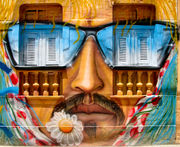
There is a significant graffiti tradition in South America most especially in Brazil. Within Brazil, São Paulo is generally considered to be the current centre of inspiration for many graffiti artists worldwide.[23]
Brazil "boasts a unique and particularly rich graffiti scene ... [earning] it an international reputation as the place to go for artistic inspiration."[24] Graffiti "flourishes in every conceivable space in Brazil's cities."[24] Artistic parallels "are often drawn between the energy of São Paulo today and 1970s New York."[25] The "sprawling metropolis,"[25] of São Paulo has "become the new shrine to graffiti;"[25] Manco alludes to "poverty and unemployment ... [and] the epic struggles and conditions of the country's marginalised peoples,"[26] and to "Brazil's chronic poverty,"[27] as the main engines that "have fuelled a vibrant graffiti culture."[27] In world terms, Brazil has "one of the most uneven distributions of income. Laws and taxes change frequently."[26] Such factors, Manco argues, contribute to a very fluid society, riven with those economic divisions and social tensions that underpin and feed the "folkloric vandalism and an urban sport for the disenfranchised,"[27] that is South American graffiti art.
Middle East
Graffiti in the Middle East is slowly emerging, with pockets of taggers operating in the various 'Emirates' of the United Arab Emirates, in Israel, and in Iran. The major Iranian newspaper Hamshahri has published two articles on illegal writers in the city with photo coverage of Iranian artist A1one's works on Tehran walls. Tokyo-based design magazine PingMag has interviewed A1one and featured photos of his work.[28] The Israeli West Bank barrier has become a site for graffiti, reminiscent in this sense of the Berlin Wall. Many graffiti artists in Israel come from other places around the globe, such as JUIF, from Los Angeles, and DEVIONE from London. The religious reference "נ נח נחמ נחמן מאומן" ("Na Nach Nachma Nachman Meuman") is commonly seen graffitied around Israel.
Methods and production
The modern day graffiti artist can be found with an arsenal of various materials that allow for a successful production of a piece.[29] This includes such techniques as scribing. However, spray paint in aerosol cans is the number one necessity for graffiti. From this commodity come different styles, technique, and abilities to form master works of visual graffiti. Spray paint can be found at hardware and art stores and come in virtually every color.
Stencil graffiti, originating in the early 1980s, is created by cutting out shapes and designs in a stiff material (such as cardboard or subject folders) in order to form an overall design or image.[30] The stencil is then placed on the canvas gently and with quick, easy strokes of the aerosol can, the image begins to appear on the intended surface. This method of graffiti is popular amongst artists because of its swift technique that requires very little time. Time is always a factor with graffiti due to the constant threat of getting caught by law enforcement.
Modern experimentation
Modern graffiti art often incorporates additional arts and technologies. For example, Graffiti Research Lab has encouraged the use of projected images and magnetic light-emitting diodes as new media for graffiti writers. The Italian artist Kaso is pursuing regenerative graffiti through experimentation with abstract shapes and deliberate modification of previous graffiti artworks. Yarnbombing is another recent form of graffiti. Yarnbombers occasionally target previous graffiti for modification.
Characteristics of common graffiti
Some of the most common styles of graffiti have their own names. A "tag" is the most basic writing of an artist's name, it is simply a handstyle. A graffiti writer's tag is his or her personalized signature. Tagging is often the example given when opponents of graffiti refer to any acts of handstyle graffiti writing (it is by far the most common form of graffiti). Tags can contain subtle and sometimes cryptic messages, and might incorporate the artist's crew initials or other letters. One form of tagging known as "pissing" is the act of taking a refillable fire extinguisher and replacing the contents inside with paint, allowing for tags as high as around 20 feet. Aiming and keeping a handstyle steady in this form of tagging is very difficult, usually coming out wavy and sloppy.
Another form is the "throw-up", also known as a "bombing" which is normally painted very quickly with two or three colors, sacrificing aesthetics for speed. Throw-ups can also be outlined on a surface with one color. A "piece" is a more elaborate representation of the artist's name, incorporating more stylized letters, usually incorporating a much larger range of colors. This of course is more time consuming and increases the likelihood of the artist getting caught. A "blockbuster" or "roller" is a large piece, almost always done in a block shaped style, done simply to cover a large area solidly with two contrasting colours, sometimes with the whole purpose of blocking other writers from painting on the same wall. These are usually accomplished with extended paint rollers and gallons of cheap exterior paint.

A more complex style is "wildstyle", a form of graffiti usually involving interlocking letters and connecting points. These pieces are often harder to read by non-graffiti artists as the letters merge into one another in an often undecipherable manner. Some artists also use stickers as a quick way to catch ups. While certain critics from within graffiti culture consider this lazy, stickers can be quite detailed in their own right, and are often used in conjunction with other materials. Sticker tags are commonly done on blank postage stickers, as these can be easily acquired with no cost on the writers part.
Many graffiti artists believe that doing complex pieces involves too great an investment of time to justify the practice. Doing a piece can take (depending on experience and size) 30 minutes to months on end, as was the case for Saber MSK while working on the worlds largest graffiti piece on the LA river. Another graffiti artist can go over a piece in a matter of minutes with a simple throw up. This was exemplified by the writer "CAP" in the documentary Style Wars, who, other writers complain, ruins pieces with his quick throw ups. This became known as "capping" and is often done when there is "beef", conflict between writers.
Uses
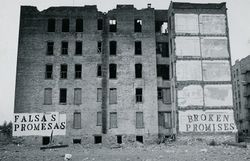
Theories on the use of graffiti by avant-garde artists have a history dating back at least to the Scandinavian Institute of Comparative Vandalism in 1961. Many contemporary analysts and even art critics have begun to see artistic value in some graffiti and to recognize it as a form of public art. According to many art researchers, particularly in the Netherlands and in Los Angeles, that type of public art is, in fact an effective tool of social emancipation or in the achievement of a political goal.[31]
The murals of Belfast and of Los Angeles offer another example of official recognition.[32] In times of conflict, such murals have offered a means of communication and self-expression for members of these socially, ethnically and/or racially divided communities, and have proven themselves as effective tools in establishing dialog and thus of addressing cleavages in the long run. The Berlin Wall was also extensively covered by Graffiti reflecting social pressures relating to the oppressive Soviet rule over the GDR.
Many artists involved with Graffiti also are concerned with the similar activity of Stencilling. Essentially, this entails stenciling a print of one or more colors using spray-paint. Recognised while exhibiting and publishing several of her coloured stencils and paintings portraying the ethnic conflict in Sri Lanka and urban Britain in the early 2000s, graffiti artist Mathangi Arulpragasam a.k.a. M.I.A. has also become known for integrating her imagery of political violence into her music videos for singles "Galang" and "Bucky Done Gun", and her cover art. Stickers of her artwork also often appear around places such as London in Brick Lane, stuck to lamp posts and street signs, having herself become a muse for other graffiti artists/painters worldwide in cities including Seville.[33] Graffiti artist John Fekner, called "caption writer to the urban environment, adman for the opposition" by writer Lucy Lippard,[34] was involved in direct art interventions within New York City's decaying urban environment in the mid-seventies through the eighties. Fekner is known for his word installations targeting social and political issues, stenciled on buildings throughout New York.
Anonymous artists
Graffiti artists constantly have the looming threat of facing consequences for displaying their graffiti. Many choose to protect their identities and reputation by remaining anonymous.
With the commercialization of graffiti (and hip hop in general), in most cases, even with legally painted "graffiti" art, graffiti artists tend to choose anonymity. This may be attributed to various reasons or a combination of reasons. Graffiti still remains the 1 of 4 hip hop elements that is not considered "performance art" despite the image of the "singing and dancing star" that sells hip hop culture to the mainstream. Being a form of visual art, it might also be said that many graffiti artists still fall in the category of the introverted archetypal artist.
Banksy is one of the world's most notorious and popular street artist who continues to remain faceless in today's society.[35] He is known for his political, anti-war stencil art mainly in Bristol, England but his work can be seen anywhere from Los Angeles to Palestine. In the UK, Banksy is the most recognizable icon for this cultural artistic movement and keeps his identity a secret to avoid arrest. Much of Banksy's artwork can be seen around the streets of London and surrounding suburbs, though he has painted pictures around the world, including the Middle East, where he has painted on Israel's controversial West Bank barrier with satirical images of life on the other side. One depicted a hole in the wall with an idyllic beach, while another shows a mountain landscape on the other side. A number of exhibitions have also taken place since 2000, and recent works of art have fetched vast sums of money. Banksy's art is a prime example of the classic controversy: vandalism vs. art. Art supporters endorse his work distributed in urban areas as pieces of art and some councils, such as Bristol and Islington, have officially protected them, while other officials have deemed his work to be vandalism and have removed it.
Pixnit is another artist who chooses to keep her identity from the general public.[36] Her work focuses on beauty and design aspects of graffiti as opposed to Banksy's anti-government shock value. Her paintings are often of flower designs above shops and stores in her local urban area of Cambridge, Massachusetts . Some store owners endorse her work and encourage others to do so as well. "One of the pieces was left up above Steve's Kitchen, because it looks pretty awesome"- Erin Scott, the manager of New England Comics in Allston.
Radical and political
Graffiti often has a reputation as part of a subculture that rebels against authority, although the considerations of the practitioners often diverge and can relate to a wide range of attitudes. It can express a political practice and can form just one tool in an array of resistance techniques. One early example includes the anarcho-punk band Crass, who conducted a campaign of stenciling anti-war, anarchist, feminist and anti-consumerist messages around the London Underground system during the late 1970s and early 1980s.[37]
In Amsterdam graffiti was a major part of the punk scene. The city was covered with names as 'De Zoot', 'Vendex' and 'Dr Rat'.[38][39] To document the graffiti a punk magazine was started called Gallery Anus. So when hip hop came to Europe in the early 1980s there already was a vibrant graffiti culture.
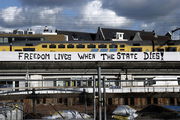
The student protests and general strike of May 1968 saw Paris bedecked in revolutionary, anarchist, and situationist slogans such as L'ennui est contre-révolutionnaire ("Boredom is counterrevolutionary") and Lisez moins, vivez plus ("Read less, live more"). While not exhaustive, the graffiti gave a sense of the millenarian and rebellious spirit, tempered with a good deal of verbal wit, of the strikers.
"I think graffiti writing is a way of defining what our generation is like. Excuse the French, we're not a bunch of p---- artists. Traditionally artists have been considered soft and mellow people, a little bit kooky. Maybe we're a little bit more like pirates that way. We defend our territory, whatever space we steal to paint on, we defend it fiercely."
The developments of graffiti art which took place in art galleries and colleges as well as "on the street" or "underground", contributed to the resurfacing in the 1990s of a far more overtly politicized art form in the subvertising, culture jamming or tactical media movements. These movements or styles tend to classify the artists by their relationship to their social and economic contexts, since, in most countries, graffiti art remains illegal in many forms except when using non-permanent paint. Since the 1990s a growing number of artists are switching to non-permanent paints for a variety of reasons—but primarily because is it difficult for the police to apprehend and for the courts to sentence or even convict a person for a protest that is as fleeting and less intrusive than marching in the streets. In some communities, such impermanent works survive longer than works created with permanent paints because the community views the work in the same vein as that of the civil protester who marches in the street—such protest are impermanent but effective nevertheless.
In some areas where a number of artist share the impermanence ideal, there grows an informal competition. That is, the length of time that a work escapes destruction is related to the amount of respect the work garners in the community. A crude work that deserves little respect would invariably be removed immediately. The most talented artist might have works last for days.
Artists whose primary object is to assert control over property—and not primarily to create of an expressive work of art, political or otherwise—resist switching to impermanent paints.
Contemporary practitioners, accordingly, have varied and often conflicting practices. Some individuals, such as Alexander Brener, have used the medium to politicize other art forms, and have used the prison sentences forced onto them as a means of further protest.[41]
The practices of anonymous groups and individuals also vary widely, and practitioners by no means always agree with each others' practices. Anti-capitalist art group the Space Hijackers, for example, did a piece in 2004 about the contradiction between the capitalistic elements of Banksy and his use of political imagery.
On top of the political aspect of graffiti as a movement, political groups and individuals may also use graffiti as a tool to spread their point of view. This practice, due to its illegality, has generally become favored by groups excluded from the political mainstream (e.g. far-left or far-right groups) who justify their activity by pointing out that they do not have the money – or sometimes the desire – to buy advertising to get their message across, and that a "ruling class" or "establishment" control the mainstream press, systematically excluding the radical/alternative point of view. This type of graffiti can seem crude; for example fascist supporters often scrawl swastikas and other Nazi images.
One innovative form of graffiti that emerged in the UK in the 1970s was devised by the Money Liberation Front (MLF), essentially a loose affiliation of underground press writers such as the poet and playwright Heathcote Williams and magazine editor and playwright Jay Jeff Jones. They initiated the use of paper currency as a medium for counterculture propaganda, overprinting banknotes, usually with a John Bull printing set. Although short lived the MLF was representative of London's Ladbroke Grove centered alternative and literary community of the period. The area was also a scene of considerable anti-establishment and humorous street graffiti much of it also produced by Williams.[42]
In 2009, following the elections in Iran, protestors (who regarded the electoral result as rigged) began to deface banknotes with slogans such as "Death to the dictator". In Colombia writing and drawing on banknotes has become increasingly popular, either to make political comments, for fun or as an artistic medium. The national government has run advertising campaigns in an attempt to discourage the practice. In the UK there have been signs of an MLF resurgence with a number of banknotes in circulation being over-marked with protest slogans such as "Banks=Robbers", relating to the perceived culpability of banks in the financial crisis.
Both sides of the conflict in Northern Ireland produce political graffiti. As well as slogans, Northern Irish political graffiti include large wall paintings, referred to as murals. Along with the flying of flags and the painting of kerb stones, the murals serve a territorial purpose, often associated with gang use. Artists paint them mostly on house gables or on the Peace Lines, high walls that separate different communities. The murals often develop over an extended period and tend to stylization, with a strong symbolic or iconographic content. Loyalist murals often refer to historical events dating from the war between James II and William III in the late 17th century, whereas Republican murals usually refer to the more recent troubles.
Territorial graffiti serves as marking ground to display tags and logos that differentiate certain groups from others. These images are meant to show outsiders a stern look at whose turf is whose. The subject matter of gang related graffiti consists of cryptic symbols and initials strictly fashioned with unique calligraphies. Gang members use graffiti to designate membership throughout the gang, to differentiate rivals and associates and, most commonly, to mark borders which are both territorial and ideological.[43]
As a means of legal and or illegal advertising
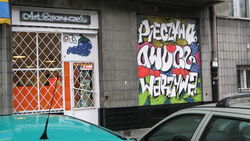
Graffiti has been used as a means of advertising both legally and illegally. In NYC, Bronx-based TATS CRU has made a name for themselves doing legal advertising campaigns for companies like Cola, McDonald's, Toyota, and MTV. In the U.K. Covent Garden's Boxfresh used stencil images of a Zapatista revolutionary in the hopes of cross referencing would promote their store. Smirnoff hired artists to use reverse graffiti (the use of high pressure hoses to clean dirty surfaces in order to leave a clean image in the surrounding dirt) to increase awareness of their product. Shepard Fairey, the artist behind the now iconic Barack Obama "HOPE" poster, rose to fame after his "Andre the Giant Has a Posse" sticker campaign, in which Fairey's art was plastered in cities all across the America. Fans of the Charlie Keeper novel have used stencil graffiti images of dragons and stylised story titles as a means to promote and support the rise of the story.
Many graffiti artists see legal advertising as no more than 'paid for and legalised graffiti' and have risen against mainstream adverts. The graffiti research lab crew have gone on to target several prominent adverts in New York as a means of making a statement against this criteria.
Offensive graffiti
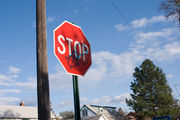
Graffiti can also be used as an offensive expression.This form of graffiti can be difficult to locate, as it is mostly removed by the local authority (as councils which have adopted strategies of criminalization also strive to remove graffiti quickly’[44]). Therefore, existing racist graffiti is mostly more subtle and at first sight not easily recognized as "racist". It can then only be understood if one knows the relevant "local code" (social, historical, political, temporal and spatial), which is seen as heteroglot and thus an 'unique set of conditions'.[45]
- A spatial code could for example be, that there is a certain youth group in an area which is engaging heavily in racist activities. So, for residents (knowing the local code), a graffiti only containing the name or abbreviation of this gang is already a racist expression, reminding the offended people of their gang activities. Also a graffiti is in most cases the herald of more serious criminal activity.[46] A person who does not know these gang activities would not be able to recognize the meaning of this graffiti. Also if a tag of this youth group or gang is placed on a building occupied by e.g. asylum-seekers it's racist character is even stronger.
Hence, the lack of obvious recist graffiti does not necessarily mean that there actually is none. By making the graffiti less explicit (as adapted to social and legal constraints[47]), these drawings are less likely to be removed but do not lose their threatening and offensive character.[48]
Decorative and high art
.jpg)
In the early eighties of the 20th century the first Art Galleries who started to show graffiti artists to the public were Fashion Moda in Bronx and Now Gallery in East Village, Manhattan.
A 2006 exhibition at the Brooklyn Museum displayed graffiti as an art form that began in New York's outer boroughs and reached great heights in the early '80s with the work of Crash, Lee, Daze, Keith Haring and Jean-Michel Basquiat.
It displayed 22 works by New York graffiti artists, including Crash, Daze and Lady Pink. In an article about the exhibition in Time Out Magazine, curator Charlotta Kotik said that she hoped the exhibition would cause viewers to rethink their assumptions about graffiti. Terrance Lindall, an artist and executive director of the Williamsburg Art and Historic Center, said regarding graffiti and the exhibition:[49]
"Graffiti is revolutionary, in my opinion", he says, "and any revolution might be considered a crime. People who are oppressed or suppressed need an outlet, so they write on walls—it's free."
In Australia, art historians have judged some local graffiti of sufficient creative merit to rank them firmly within visual art. Oxford University Press's art history text Australian Painting 1788-2000 concludes with a long discussion of graffiti's key place within contemporary visual culture, including the work of several Australian practitioners.[50]
Artistic graffiti is a modern day offspring of traditional graffiti that has elevated itself from just scrawling words or phrases on a wall, to a complex artistic form of personal expression[51]
Between March and April 2009, 150 artists exhibited 300 pieces of graffiti at the Grand Palais in Paris — a clear acceptance of the art form into the French art world.[52][53]
In 2009 graffiti artist "Scape" published "GRAFF; the Art & Technique of Graffiti", the world's first book dedicated to displaying the full techniques of creating graffiti art.
Government responses
Asia
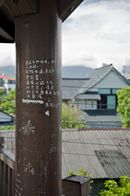
In China, graffiti began with Mao Zedong in the 1920s who used revolutionary slogans and paintings in public places to galvanise the country's communist revolution. Mao holds the record for the longest piece of graffiti, which contains 4000 characters criticising his teachers and the state of Chinese society.[54]
In Hong Kong, Tsang Tsou Choi was known as the King of Kowloon for his calligraphy graffiti over many years, in which he claimed ownership of the area. Some of his work is now officially preserved.
In 1993 in Singapore, after several expensive cars were spray-painted, the police arrested a student from the Singapore American School, Michael P. Fay, questioned him and subsequently charged him with vandalism. Fay pleaded guilty to vandalizing the car in addition to stealing road signs. Under the 1966 Vandalism Act of Singapore, originally passed to curb the spread of communist graffiti in Singapore, the court sentenced him to four months in jail, a fine of S$3,500 (US$2,233), and a caning. The New York Times ran several editorials and op-eds that condemned the punishment and called on the American public to flood the Singaporean embassy with protests. Although the Singapore government received many calls for clemency, Fay's caning took place in Singapore on 5 May 1994. Fay had originally received a sentence of six lashes of the cane, but the then President of Singapore Ong Teng Cheong agreed to reduce his caning sentence to four lashes.[55]
Europe
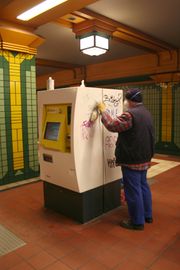
In Europe, community cleaning squads have responded to graffiti, in some cases with reckless abandon, as when in 1992 in France a local Scout group, attempting to remove modern graffiti, damaged two prehistoric paintings of bison in the Cave of Mayrière supérieure near the French village of Bruniquel in Tarn-et-Garonne, earning them the 1992 Ig Nobel Prize in archaeology.[56]

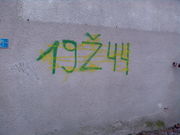
In September 2006, the European Parliament issued the European Commission to create urban environment policies in order to prevent and eliminate dirt, litter, graffiti, animals' excrement and excessive noise from domestic and vehicular music systems in European cities, along with other concerns over urban life.[57]
The Anti-Social Behaviour Act 2003 became Britain's latest anti-graffiti legislation. In August 2004, the Keep Britain Tidy campaign issued a press release calling for zero tolerance of graffiti and supporting proposals such as issuing "on the spot" fines to graffiti offenders and banning the sale of aerosol paint to anyone under the age of 16.[58] The press release also condemned the use of graffiti images in advertising and in music videos, arguing that real-world experience of graffiti stood far removed from its often-portrayed 'cool' or 'edgy' image.
To back the campaign, 123 MPs (including Prime Minister Tony Blair) signed a charter which stated: Graffiti is not art, it's crime. On behalf of my constituents, I will do all I can to rid our community of this problem.[59] However, in the last couple of years the British graffiti scene has been struck by self-titled 'art terrorist' Banksy, who has revolutionized the style of UK graffiti (bringing to the forefront stencils to aid the speed of painting) as well as the content; making his work largely satirical of the sociological state of cities, or the political climate of war, often using monkeys and rats as motifs.
In the UK, city councils have the power to take action against the owner of any property that has been defaced under the Anti-social Behaviour Act 2003 (as amended by the Clean Neighbourhoods and Environment Act 2005) or, in certain cases, the Highways Act. This is often used against owners of property that are complacent in allowing protective boards to be defaced so long as the property is not damaged.
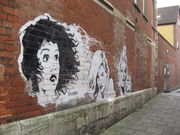
In July 2008, a conspiracy charge was used to convict graffiti artists for the first time. After a three-month police surveillance operation,[60] nine members of the DPM crew were convicted of conspiracy to commit criminal damage costing at least £1 million. Five of them received prison sentences, ranging from 18 months to two years. The unprecedented scale of the investigation and the severity of the sentences rekindled public debate over whether graffiti should be considered art or crime.[61]
Some councils, like that at Stroud, Gloucestershire provide approved areas round the town where graffiti artists can showcase their talents, including underpasses, car parks and walls that might otherwise prove a target for the 'spray and run.'[62]
In Budapest, Hungary both a city-backed movement called I Love Budapest and a special police division tackle the problem, including the provision of approved areas.[63][64]
Australia
In an effort to reduce vandalism, many cities in Australia have designated walls or areas exclusively for use by graffiti artists. One early example is the "Graffiti Tunnel" located at the Camperdown Campus of the University of Sydney, which is available for use by any student at the University to tag, advertise, poster and create "art". Advocates of this idea suggest that this discourages petty vandalism yet encourages artists to take their time and produce great art, without worry of being caught or arrested for vandalism or trespassing.[65][66] Others disagree with this approach, arguing that the presence of legal graffiti walls does not demonstrably reduce illegal graffiti elsewhere.[67] Some Local Government Areas around Australia have introduced "anti-graffiti squads", who clean graffiti in the area, and such gangs as BCW (Buffers Can't Win) have taken steps to keep one step ahead of local graffiti cleaners.
Many state governments have banned the sale or possession of spray paint to those under the age of 18 (age of majority). However, a number of Local Governments in Victoria have taken steps to recognize the cultural heritage value of some examples of graffiti, such as prominent political graffiti. Tough new graffiti laws have been introduced in Australia with fines of up to A$26,000 and two years in prison.
Melbourne is a prominent graffiti city of Australia with many of its lanes being tourist attractions, such as Hosier Lane in particular, a popular destination for photographers, wedding photography and backdrops for corporate print advertising. The Lonely Planet travel guide cites Melbourne's street are as a major attraction. Everything including; sticker art, poster, stencil art and wheatpasting can be found in many places throughout the city. Prominent street art precincts include; Fitzroy, Collingwood, Northcote, Brunswick, St. Kilda and the CBD, where stencil and sticker art is prominent. As you move further away from the city, mostly along suburban train lines, graffiti tags become more prominent. Many international artists such as Banksy have left their work in Melbourne and in early 2008 a perspex screen was installed to prevent a Banksy stencil art piece from being destroyed, it has survived since 2003 through the respect of local street artists avoiding posting over it, although it has recently had paint tipped over it.[68]
New Zealand
In February 2008 Helen Clark, the New Zealand Prime Minister at that time, announced a government crackdown on tagging and other forms of graffiti vandalism, describing it as a destructive crime representing an invasion of public and private property. New legislation subsequently adopted included a ban on the sale of paint spray cans to persons under 18 and increases in maximum fines for the offence from NZ$200 to NZ$2,000 or extended community service. The issue of tagging become a widely debated one following an incident in Auckland during January 2008 where a middle aged property owner stabbed one of two teenage taggers to death and was subsequently convicted of manslaughter.
United States
Documentaries and films
- 80 Blocks from Tiffany's (1979), A rare glimpse into late '70s New York towards the end of the infamous South Bronx Gangs. The documentary shows many sides of the mainly Puerto Rican community of the South Bronx including, reformed gang members, current gang members, the police, and the community leaders who try and reach out to them.
- Stations of the Elevated (1980), the earliest documentary about subway graffiti in New York City, with music by Charles Mingus
- Wild Style (1983), a drama about hip hop and graffiti culture in New York City
- Style Wars (1983), an early documentary on hip hop culture, made in New York City
- Quality of Life (2004) a graffiti drama shot in the Mission District of San Francisco, starring/co-written by a retired graffiti writer.
- Piece by Piece (2005), a feature length documentary on the history of San Francisco graffiti from the early 1980s until the present day.
- Infamy (2005), A feature-length documentary about graffiti culture as told through the experiences of six well-known graffiti writers and a graffiti buffer.
- NEXT: A Primer on Urban Painting (2005), a documentary about global graffiti culture
- RASH (film) (2005), a feature documentary about Melbourne, Australia and the artists who make it a living host for illegal artwork called street art.
- Bomb the System (2002), a drama about a crew of graffiti artists in modern day New York City
- BOMB IT (2007), a graffiti and street art documentary filmed on 5 continents.
- Jisoe (2007), a glimpse into the life of a Melbourne (AUS) graffiti writer. Shows the audience an example of graffiti in struggling Melbourne areas
- Roadsworth: Crossing the Line (2009) is a Canadian documentary about Montréal artist Peter Gibson and his controversial stencil art on public roads.
See also
- Graffiti abatement
- Graffiti terminology
- Kilroy was here
- Kotwica
- Spray paint art
- Stencil
- Street art
- Vandalism
- Visual pollution
- Yarn bombing
References
- ↑ "Graffito". Oxford English Dictionary. 2. Oxford University Press. 2006.
- ↑ "Mistery Interview." Powderbomb. 1 Mar. 2009
- ↑ Stowers, George C. (1 March 2009). "Graffiti Art: An Essay Concerning The Recognition of Some Forms of Graffiti As Art.". HipHop-Network. http://www.hiphop-network.com/articles/graffitiarticles/graffitiart.asp.
- ↑ Mike Von Joel. "Urbane Guerrillas". http://www.state-of-art.org/state-of-art/ISSUE%20FOUR/urbane4.html. Retrieved 2006-10-18.
- ↑ Ancelet, Jeanine (2006). "The history of graffiti". UCL — London's Global University. http://www.ucl.ac.uk/museumstudies/websites06/ancelet/thehistoryofgraffiti.htm. Retrieved 20 Apr. 2009.
- ↑ Olmert, Michael (1996). Milton's Teeth and Ovid's Umbrella: Curiouser & Curiouser Adventures in History, p.48-49. Simon & Schuster, New York. ISBN 0-684-80164-7.
- ↑ Tacherons on Romanesque churches
- ↑ British Archaeology, June 1999
- ↑ The Atlantic Monthly, April 97.
- ↑ "Art Crimes". Jinx Magazine. Unknown. http://www.jinxmagazine.com/art_crimes.html.
- ↑ p. 76, Classical Archaeology of Greece: Experiences of the Discipline, Michael Shanks, London, New York: Routledge, 1996, ISBN 0-415-08521-7.
- ↑ [1] Some sort of video about Texino
- ↑ Ross Russell. Bird Lives!: The High Life And Hard Times Of Charlie (yardbird) Parker Da Capo Press.
- ↑ "Missing Foundation op MySpace Music – Gratis gestreamde MP3's, foto's en Videoclips". Profile.myspace.com. http://profile.myspace.com/index.cfm?fuseaction=user.viewProfile&friendID=61945507. Retrieved 2010-07-29.
- ↑ Labonte, Paul. All City: The book about taking space. Toronto. ECW Press. 2003
- ↑ David Hershkovits, "London Rocks, Paris Burns and the B-Boys Break a Leg", Sunday News Magazine, April 3, 1983.
- ↑ Ellis, Rennie, The All New Australian Graffiti (Sun Books, Melbourne, 1985) ISBN 0-7251-0484-8
- ↑ Niccolai, James (2001-04-19). "IBM's graffiti ads run afoul of city officials". CNN. http://archives.cnn.com/2001/TECH/industry/04/19/ibm.guerilla.idg/index.html. Retrieved 2006-10-11.
- ↑ 19.0 19.1 "Sony Draws Ire With PSP Graffiti". Wired. 2005-12-05. http://www.wired.com/culture/lifestyle/news/2005/12/69741. Retrieved 2008-04-08.
- ↑ "Marc Ecko Hosts "Getting Up" Block Party For NYC Graffiti, But Mayor Is A Hater". SOHH.com. 2005-08-17. http://www.sohh.com/articles/article.php/7428. Retrieved 2006-10-11.
- ↑ 21.0 21.1 Ganz, Nicolas. "Graffiti World". New York. Abrams. 2004
- ↑ "123Klan Interview". Samuel Jesse — Gráfica Real. 2009-01-27. http://graficareal.net/index.php/interviews/graffiti-to-graphic-design-kings-of-evolution-part-1-123klan-interview/. Retrieved 2009-03-03.
- ↑ Tristan Manco São Paulo pics on flikr.com
- ↑ 24.0 24.1 Manco, Tristan. Lost Art & Caleb Neelon, Graffiti Brazil. London: Thames and Hudson, 2005, 7.
- ↑ 25.0 25.1 25.2 Manco, 9
- ↑ 26.0 26.1 Manco, 8
- ↑ 27.0 27.1 27.2 Manco, 10
- ↑ Uleshka, "A1one: 1st generation Graffiti in Iran", PingMag, 19 January 2005.
- ↑ Ganz, Nicolas. "Graffiti World". New York. Abrams. 2004.
- ↑ Drupal (17 Apr. 2009). "Stencil graffiti tutorial — Learn to design graffiti stencils". Stencil Revolution (onelegout.com). http://www.onelegout.com/stencil_tutorial.html.
- ↑ "P(ART)icipation and Social Change (.doc file)" (DOC). 2002-01-25. http://www.jss.org.au/media/docs/participation.doc. Retrieved 2006-10-11.
- ↑ "Pictures of Murals of Los Angeles". http://rpmurals.home.att.net/.
- ↑ "Graffiti Telecinco". YouTube. http://es.youtube.com/watch?v=THzQQ_OdTC0. Retrieved 2008-07-24.
- ↑ Lippard, Lucy, All Fired Up, Village Voice, December 2–8, 1981
- ↑ Banksy. Wall and Piece. New York: Random House UK, 2005.
- ↑ Shaer, Matthew (3 Jan. 2007). "Pixnit Was Here". The Boston Globe. http://www.boston.com/ae/theater_arts/articles/2007/01/03/pixnit_was_here/. Retrieved 1 Mar. 2009.
- ↑ "Crass Discography (Christ's reality asylum)". Southern Records. unknown. http://www.southern.com/southern/label/CRC/09400a.html. Retrieved 2006-10-11.
- ↑ SFT: Ny dokumentär reder ut graffitins punkiga rötter. Dr Rat died in 1981 of an overdose at the age of 20 and was somewhat of an underground hero.
- ↑ Kroonjuwelen
- ↑ Chang, Jeff (2005). Can't Stop Won't Stop: A History of the Hip-Hop Generation. New York: St. Martin's Press. p. 124. ISBN 0-312-30143-X.
- ↑ "Border Crossings". Village Voice. 2000-08-01. http://www.villagevoice.com/art/0030,levin,16706,13.html. Retrieved 2006-10-11.
- ↑ http://www.historytalk.org/Notting%20Hill%20History%20Timeline/timelinechap13.pdf
- ↑ Ley, David; Roman Cybriwsky (Dec. 1974.). "Urban Graffiti as Territorial Markers". Tucson.: JSTOR. University of Arizona Library. http://www.jstor.org/. Retrieved 14 Mar. 2009.
- ↑ Halsey, M.; Young, A. (2002), "The Meanings of Graffiti and Municipal Administration", Australian and New Zealand Journal of Criminology 35 (2): 165–86
- ↑ Holquist, M. (1981). "'Glossary'". In Bakhtin, M.M.. The Dialogic Imagination. Austin: University of Texas Press. p. 423.
- ↑ Kelling, G.; Coles, C. (1996). Fixing Broken Windows. New York: Martin Kessler Books.
- ↑ Barker, M. (1981). The New Racism. London: Junction Books.
- ↑ Lynn, Nick; Lea, Susan J. (2005), "‘Racist’ graffiti: text, context and social comment", Visual Communication 4: 39–63, doi:10.1177/1470357205048935
- ↑ "Writing on the Wall". Time Out New York Kids. 2006. Archived from the original on 2006-11-13. http://web.archive.org/web/20061113004456/http://www.tonykids.com/features/13/k13.ft.writing.html. Retrieved 2006-10-11.
- ↑ Bernard Smith, Terry Smith and Christopher Heathcote, Australian Painting 1788-2000, Oxford University Press, Melbourne, 2001, chapter 17. See also Christopher Heathcote, Discovering Graffiti, Art Monthly Australia (Canberra), September 2000, pp. 4–8.
- ↑ [2]
- ↑ "RFI - Graffiti gets into the Grand Palais". Rfi.fr. http://www.rfi.fr/actuen/articles/112/article_3517.asp. Retrieved 2010-07-29.
- ↑ Rohter, Larry (2009-03-30). "Toasting Graffiti Artists". The New York Times. http://www.nytimes.com/2009/03/30/arts/design/30arts-TOASTINGGRAF_BRF.html. Retrieved 2010-04-02.
- ↑ BBC NEWS | In pictures: Graffiti artists in Beijing, Graffiti tradition
- ↑ Shenon, Philip (05-08-1994). "Singapore Swings; Michael Fay's Torture's Over; Watch for the Docudrama". New York Times. http://query.nytimes.com/gst/fullpage.html?res=940DE1DA1539F93BA35756C0A962958260. Retrieved 2010-04-02.
- ↑ "1992 Ig Nobel Prize Winners". http://www.improb.com/ig/ig-pastwinners.html#ig1992.
- ↑ Thematic strategy on the urban environment — European Parliament resolution on the thematic strategy on the urban environment (2006/2061(INI))
- ↑ EnCams. "Graffiti". Press release.
- ↑ "Is the Writing on the Wall for Graffiti". PR News Wire. 2004-07-28. http://www.prnewswire.co.uk/cgi/news/release?id=127383.
- ↑ "Jail for leader of graffiti gang". BBC News. 2008-07-11. http://news.bbc.co.uk/1/hi/england/london/7502768.stm. Retrieved 2008-07-17.
- ↑ Arifa Akbar; Paul Vallely (2008-07-16). "Graffiti: Street art – or crime?". London: The Independent. http://www.independent.co.uk/arts-entertainment/art-and-architecture/features/graffiti-street-art-ndash-or-crime-868736.html. Retrieved 2008-07-17.
- ↑ [3] BBC Gloucestershire
- ↑ http://bunmegelozes.easyhosting.hu/dok/varosok_osszegzes_2.doc
- ↑ "Index - Belföld - Kommandó üldözi a graffitiseket". Index.hu. 2010-03-14. http://index.hu/belfold/budapest/2010/03/14/bealkonyult_a_falfirkanak_budapesten/. Retrieved 2010-07-29.
- ↑ "Legal Graffiti Wall Rules". Warringah Council. http://www.warringah.nsw.gov.au/rules.htm.
- ↑ "Newcastle beach to get 'legal graffiti' wall". ABC News Online. 2005-05-25. http://www.abc.net.au/news/australia/nsw/newcastle/200505/s1376470.htm.
- ↑ "Against the wall". North Shore:Towns Online.com. 08-11-06. http://www.townonline.com/lynnfield/localRegional/view.bg?articleid=555224.
- ↑ "The painter painted: Melbourne loses its treasured Banksy". http://www.watoday.com.au/national/the-painter-painted-melbourne-loses-its-treasured-banksy-20081213-6xzy.html. Retrieved 30 June 2009.
External links
- Art Crimes, leading contemporary Graffiti-related website
- Art of graffiti
- ekosystem
- Ancient Graffiti of Saudi Arabia
- A TIME Archives Collection of Graffiti's progression
- World Wide Graffiti Gallery — established 1997
- Canned Goods — providing interviews with graffiti artists worldwide]
- Belarusian graffiti
- Big Art Mob — a user-created pictorial map of graffiti and street art across the United Kingdom
- World Graffiti — features photographs of graffiti from around the world
 "Graffiti". New International Encyclopedia. 1905.
"Graffiti". New International Encyclopedia. 1905.
|
||||||||||||||||
|
|||||||||||||||||||||||||||||
